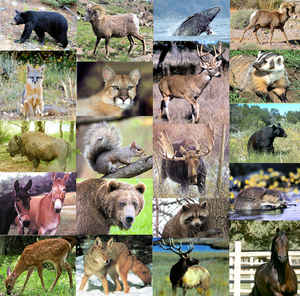New York State Animal
Beaver

(Castor canadensis)
Adopted in 1975.
The beaver, (Castor canadensis,) was adopted as the State animal in 1975. Adult beavers are three to four feet long and weigh 40 to 50 pounds. They build dams by packing mud with their long, flat tails. To provide beaver pelts to European markets in the early 1600s, fur traders settled near the present capital, Albany, to trade with Indians.
New York State Animal: Beaver

Beavers are primarily aquatic animals, and the largest rodents in North America. They have a waterproof, rich, glossy, reddish
brown or blackish brown coat. The underhairs are much finer than the outer, protective, guard-hairs. The ears are short, round, and dark brown in coloration.
A beaver's hind legs are longer than its front legs, thus making the rear end to be higher than the front end while walking. ("Data: Species: Mammal:
American Beaver- Castor canadiensis", 1998; Frazier, 1996; Hall and Kelson, 1959; Whitaker and Hamilton, 1998)
Beaver skulls and teeth are disproportionately large. This is crucial for cutting through hard woods like maple and oak. Most noteably, the upper incisors,
bright orange in color, are at least 5 mm wide and 20-25 mm long. These teeth grow throughout the animal's lifetime and are a necessity to survival,
just as the animal's closable nostrils, closable ears, and transparent eye membranes are for aquatic existence. (Hall and Kelson, 1959; Whitaker and
Hamilton, 1998)
Also notable are the anal and castor glands, found in both male and female beavers. Both sets of glands lie at the base of the tail, which is possibly
the most defining characteristic of the beaver. It is broad, flat, and covered in large blackish scales. The anal and castor glands have been recorded
as large as 3.4 by 2.2 inches for the castors, and 3.0 by 1 inch for the anal glands. Secretions from these glands are used in scent-marking, and give
the beaver its odd odor. (Frazier, 1996; Hall and Kelson, 1959; Whitaker and Hamilton, 1998)
Beavers also have anal and castor glands, which they use to mark their territory. These glands are located beneath the tail. A beaver's tail is broad,
flat, and covered with large black scales. (Frazier, 1996; Hall and Kelson, 1959; Whitaker and Hamilton, 1998)
Behavior

Beavers usually live in family groups of up to 8 related individuals called colonies. The younger siblings stay with their parents for up to 2 years,
helping with infant care, food collection, and dam building. Beaver families are territorial and defend against other families. One method is territory
marking. This is done by making mud piles around the edges of a territory, and then by depositing anal and castoral secretions on these piles. Beavers
will also warn others of danger by slapping their tails against the water, creating a powerful noise. This, however, is not always effective, as olders
beavers will often ignore the warning slaps of younger members of the colony. ("Data: Species: Mammal: American Beaver- Castor canadiensis", 1998;
Frazier, 1996; Hall and Kelson, 1959; Whitaker and Hamilton, 1998)
Beavers are primarily nocturnal. They are only occasionally seen during the day, usually around dusk. Beavers travel good distances from their homes
to find food. If they find a good source, they build canals to the food source as a way to float the food back to their lodges. Logs and twigs are
often stored underwater for winter feeding. ("Data: Species: Mammal: American Beaver- Castor canadiensis", 1998; Frazier, 1996; Hall and Kelson, 1959)
Beavers build dams to slow down the flow of water in streams and rivers and then build stable lodges for shelter. The dams are engineered according
to the speed of the water; in slow water the dam is built straight, but in fast water the dam is built with a curve in it. This provides stability
so that the dam will not be washed away. ("Data: Species: Mammal: American Beaver- Castor canadiensis", 1998; Frazier, 1996; Hall and Kelson, 1959)
New York Law
The law designating the American beaver as the official New York state mammal is found in the New York State Consolidated Laws, State, Article 6, Section 79.
STL - State
ARTICLE 6 - ARMS AND GREAT SEAL OF STATE
SECTION 86
§ 79. State animal. The American beaver (Castor canadensis) shall be the official animal of the state of New York.
Taxonomic Hierarchy: American Beaver
Kingdom: Animalia
Phylum: Chordata
Class: Mammalia
Order: Rodentia
Family: Castoridae
Genus: Castor
Species: C. canadensis








